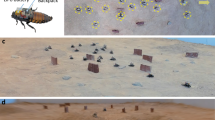Abstract
Recently, robots that operate in complex real environments, such as rescue robots and nursing-care robots, have been proposed and developed. However, controlling a robot in a complex environment remains very difficult, and therefore, the study of autonomous control of a robot is one of the most important topics in robotics. In this study, we modeled a dragonfly’s behavior and conducted dynamic simulations of chasing behavior. To validate the role of real-world properties, we analyzed the simulation results and showed that by using real-world properties, the computational cost of the autonomous controller can be reduced considerably and interception behavior can be realized by a simple controller without estimating the movement of the prey.













Similar content being viewed by others
Explore related subjects
Discover the latest articles, news and stories from top researchers in related subjects.References
Borenstein J, Koren Y (1990) Real-time obstacle avoidance for fast mobile robot in cluttered environments. J Robot Autom 572–577
MWMG Dissanayake, P Newman, S Clark, HF. Durrant-Whyte and M Csorba (2006) A solution to the simultaneous localisation and map building (SLAM) problem. Australian Centre for Field Robotics Department of Mechatronic Engineering the University of Sydney NSW, Australia 1–14
Davison Andrew J, Reid Ian D, Molton Nicholas D, Stasse Olivier (2007) MonoSLAM: real-time single camera SLAM. J IEEE Trans Pattern Anal Mach Intell 29(6):1052–1067
Olberg RM, Seaman RC, Coats MI, Henry AF (2007) Eye movements and target fixation during dragonfly prey-interception flights. J Comp Physiol A 7:685–693
Olberg RM, Worthington AH, Venator KR (2000) Prey pursuit and interception in dragonflies. J Comp Physiol A 186(2):155–162
Author information
Authors and Affiliations
Corresponding author
Additional information
This work was presented in part at the 19th International Symposium on Artificial Life and Robotics, Beppu, Oita, January 22–24, 2014.
About this article
Cite this article
Ito, K., Sakuraba, N. Importance of real-world properties in chasing task: simulation and analysis of dragonfly’s behavior. Artif Life Robotics 19, 370–374 (2014). https://doi.org/10.1007/s10015-014-0176-7
Received:
Accepted:
Published:
Issue Date:
DOI: https://doi.org/10.1007/s10015-014-0176-7




